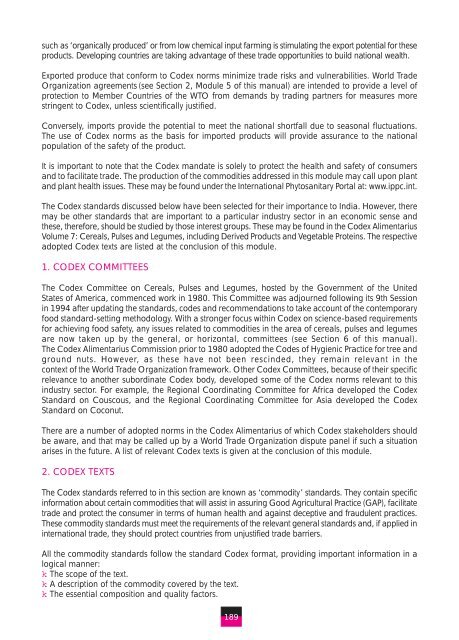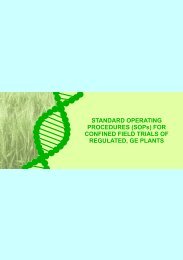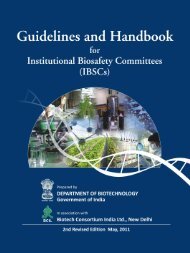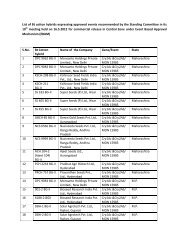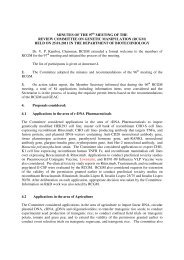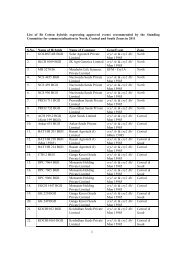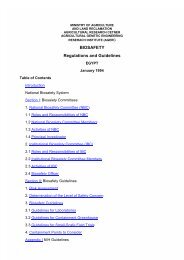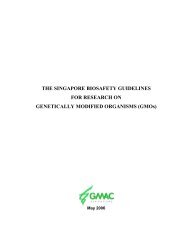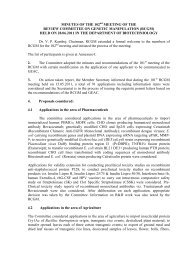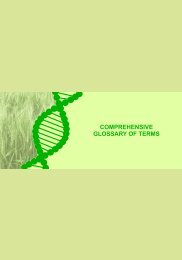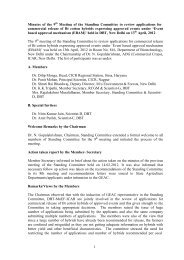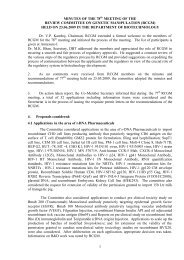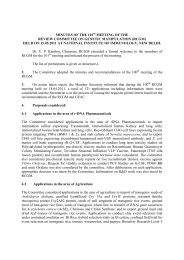THE USER'S MANUAL ON CODEX - Department of Biotechnology
THE USER'S MANUAL ON CODEX - Department of Biotechnology
THE USER'S MANUAL ON CODEX - Department of Biotechnology
You also want an ePaper? Increase the reach of your titles
YUMPU automatically turns print PDFs into web optimized ePapers that Google loves.
such as ‘organically produced’ or from low chemical input farming is stimulating the export potential for these<br />
products. Developing countries are taking advantage <strong>of</strong> these trade opportunities to build national wealth.<br />
Exported produce that conform to Codex norms minimize trade risks and vulnerabilities. World Trade<br />
Organization agreements (see Section 2, Module 5 <strong>of</strong> this manual) are intended to provide a level <strong>of</strong><br />
protection to Member Countries <strong>of</strong> the WTO from demands by trading partners for measures more<br />
stringent to Codex, unless scientifically justified.<br />
Conversely, imports provide the potential to meet the national shortfall due to seasonal fluctuations.<br />
The use <strong>of</strong> Codex norms as the basis for imported products will provide assurance to the national<br />
population <strong>of</strong> the safety <strong>of</strong> the product.<br />
It is important to note that the Codex mandate is solely to protect the health and safety <strong>of</strong> consumers<br />
and to facilitate trade. The production <strong>of</strong> the commodities addressed in this module may call upon plant<br />
and plant health issues. These may be found under the International Phytosanitary Portal at: www.ippc.int.<br />
The Codex standards discussed below have been selected for their importance to India. However, there<br />
may be other standards that are important to a particular industry sector in an economic sense and<br />
these, therefore, should be studied by those interest groups. These may be found in the Codex Alimentarius<br />
Volume 7: Cereals, Pulses and Legumes, including Derived Products and Vegetable Proteins. The respective<br />
adopted Codex texts are listed at the conclusion <strong>of</strong> this module.<br />
1. <strong>CODEX</strong> COMMITTEES<br />
The Codex Committee on Cereals, Pulses and Legumes, hosted by the Government <strong>of</strong> the United<br />
States <strong>of</strong> America, commenced work in 1980. This Committee was adjourned following its 9th Session<br />
in 1994 after updating the standards, codes and recommendations to take account <strong>of</strong> the contemporary<br />
food standard-setting methodology. With a stronger focus within Codex on science-based requirements<br />
for achieving food safety, any issues related to commodities in the area <strong>of</strong> cereals, pulses and legumes<br />
are now taken up by the general, or horizontal, committees (see Section 6 <strong>of</strong> this manual).<br />
The Codex Alimentarius Commission prior to 1980 adopted the Codes <strong>of</strong> Hygienic Practice for tree and<br />
ground nuts. However, as these have not been rescinded, they remain relevant in the<br />
context <strong>of</strong> the World Trade Organization framework. Other Codex Committees, because <strong>of</strong> their specific<br />
relevance to another subordinate Codex body, developed some <strong>of</strong> the Codex norms relevant to this<br />
industry sector. For example, the Regional Coordinating Committee for Africa developed the Codex<br />
Standard on Couscous, and the Regional Coordinating Committee for Asia developed the Codex<br />
Standard on Coconut.<br />
There are a number <strong>of</strong> adopted norms in the Codex Alimentarius <strong>of</strong> which Codex stakeholders should<br />
be aware, and that may be called up by a World Trade Organization dispute panel if such a situation<br />
arises in the future. A list <strong>of</strong> relevant Codex texts is given at the conclusion <strong>of</strong> this module.<br />
2. <strong>CODEX</strong> TEXTS<br />
The Codex standards referred to in this section are known as ‘commodity’ standards. They contain specific<br />
information about certain commodities that will assist in assuring Good Agricultural Practice (GAP), facilitate<br />
trade and protect the consumer in terms <strong>of</strong> human health and against deceptive and fraudulent practices.<br />
These commodity standards must meet the requirements <strong>of</strong> the relevant general standards and, if applied in<br />
international trade, they should protect countries from unjustified trade barriers.<br />
All the commodity standards follow the standard Codex format, providing important information in a<br />
logical manner:<br />
k The scope <strong>of</strong> the text.<br />
k A description <strong>of</strong> the commodity covered by the text.<br />
k The essential composition and quality factors.<br />
189


